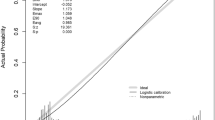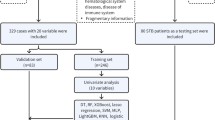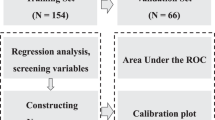Abstract
Study design
A 5-year longitudinal, retrospective, cohort study.
Objectives
Develop a prediction model based on electronic health record (EHR) data to identify veterans with spinal cord injury/diseases (SCI/D) at highest risk for new pressure injuries (PIs).
Setting
Structured (coded) and text EHR data, for veterans with SCI/D treated in a VHA SCI/D Center between October 1, 2008, and September 30, 2013.
Methods
A total of 4709 veterans were available for analysis after randomly selecting 175 to act as a validation (gold standard) sample. Machine learning models were created using ten-fold cross validation and three techniques: (1) two-step logistic regression; (2) regression model employing adaptive LASSO; (3) and gradient boosting. Models based on each method were compared using area under the receiver-operating curve (AUC) analysis.
Results
The AUC value for the gradient boosting model was 0.62 (95% CI = 0.54–0.70), for the logistic regression model it was 0.67 (95% CI = 0.59–0.75), and for the adaptive LASSO model it was 0.72 (95% CI = 0.65–80). Based on these results, the adaptive LASSO model was chosen for interpretation. The strongest predictors of new PI cases were having fewer total days in the hospital in the year before the annual exam, higher vs. lower weight and most severe vs. less severe grade of injury based on the American Spinal Cord Injury Association (ASIA) Impairment Scale.
Conclusions
While the analyses resulted in a potentially useful predictive model, clinical implications were limited because modifiable risk factors were absent in the models.
This is a preview of subscription content, access via your institution
Access options
Subscribe to this journal
Receive 12 print issues and online access
$259.00 per year
only $21.58 per issue
Buy this article
- Purchase on Springer Link
- Instant access to full article PDF
Prices may be subject to local taxes which are calculated during checkout


Similar content being viewed by others
Data availability
The datasets generated during and/or analyzed during the current study are not publicly available due the fact that they included Individually Identifiable Data which can only be shared pursuant to a written request and IRB approved waiver of HIPAA authorization, with the approval of the Under Secretary for Health, in accordance with VHA Handbook 1605.1 §13.b(1)(b) or §13.b(1)(c) or superseding versions of that Handbook.
References
Chen HL, Cai JY, Du L, Shen HW, Yu HR, Song YP, et al. Incidence of pressure injury in individuals with spinal cord injury: a systematic review and meta-analysis. J Wound Ostomy Cont Nurs. 2020;47:215–23.
Hogaboom NS, Worobey LA, Houlihan BV, Heinemann AW, Boninger ML. Wheelchair breakdowns are associated with pain, pressure injuries, rehospitalization, and self-perceived health in full-time wheelchair users with spinal cord injury. Arch Phys Med Rehabil. 2018;99:1949–56.
European Pressure Ulcer Panel, National Pressure Injury Advisory Panel, Pan Pacific Pressure Injury Alliance. prevention and treatment of pressure ulcers/injuries. EPUAP/NPIAP/PPPIA; 2019. Available from: https://guidelinesales.com/page/NPIAP.
Edsberg LE, Langemo D, Baharestani MM, Posthauer ME, Goldberg M. Unavoidable pressure injury: state of the science and consensus outcomes. J Wound Ostomy Cont Nurs. 2014;41:313–34.
Groah SL, Schladen M, Pineda CG, Hsieh CHJ. Prevention of pressure ulcers among people with spinal cord injury: a systematic review. PM R. 2015;7:613–36.
Moore ZE, Patton D. Risk assessment tools for the prevention of pressure ulcers. Cochrane Database Syst Rev. 2019;1:CD006471.
Källman U, Lindgren M. Predictive validity of 4 risk assessment scales for prediction of pressure ulcer development in a hospital setting. Advances in skin & wound care [Internet]. 2014 Feb [cited 2022 Oct 17]. Available from: https://pubmed.ncbi.nlm.nih.gov/24440864/.
Flett HM, Delparte JJ, Scovil CY, Higgins J, Laramée MT, Burns AS. Determining pressure injury risk on admission to inpatient spinal cord injury rehabilitation: a comparison of the FIM, Spinal Cord Injury Pressure Ulcer Scale, and Braden Scale. Arch Phys Med Rehabil. 2019;100:1881–7.
Bogie KM, Roggenkamp SK, Zeng N, Seton JM, Schwartz KR, Henzel MK, et al. Development of predictive informatics tool using electronic health records to inform personalized evidence-based pressure injury management for veterans with spinal cord injury. Mil Med. 2021;186:651–8.
Burkhart L, Skemp L, Siddiqui S. Veteran model of preventing community-acquired pressure injuries associated with spinal cord injury: a qualitative descriptive study. J Spinal Cord Med. 2021;1–15 https://doi.org/10.1080/10790268.2021.1982177.
Bi Q, Goodman KE, Kaminsky J, Lessler J. What is machine learning? A primer for the epidemiologist. Am J Epidemiol. 2019;188:2222–39.
Shamout F, Zhu T, Clifton DA. Machine learning for clinical outcome prediction. IEEE Rev Biomed Eng. 2021;14:116–26.
Davis SE, Lasko TA, Chen G, Siew ED, Matheny ME. Calibration drift in regression and machine learning models for acute kidney injury. J Am Med Inf Assoc. 2017;24:1052–61.
Koola JD, Ho S, Chen G, Perkins AM, Cao A, Davis SE, et al. Development of a national Department of Veterans Affairs mortality risk prediction model among patients with cirrhosis. BMJ Open Gastroenterol. 2019;6:e000342.
Sánchez-Cabo F, Rossello X, Fuster V, Benito F, Manzano JP, Silla JC, et al. Machine learning improves cardiovascular risk definition for young, asymptomatic individuals. J Am Coll Cardiol. 2020;76:1674–85.
Stark GF, Hart GR, Nartowt BJ, Deng J. Predicting breast cancer risk using personal health data and machine learning models. PLoS ONE. 2019;14:e0226765.
Alderden J, Pepper GA, Wilson A, Whitney JD, Richardson S, Butcher R, et al. Predicting pressure injury in critical care patients: a machine-learning model. Am J Crit Care. 2018;27:461–8.
Lee SK, Ahn J, Shin JH, Lee JY. Application of machine learning methods in nursing home research. Int J Environ Res Public Health. 2020;17:E6234.
Cai JY, Zha ML, Song YP, Chen HL. Predicting the development of surgery-related pressure injury using a machine learning algorithm model. J Nurs Res. 2020;29:e135.
Song W, Kang MJ, Zhang L, Jung W, Song J, Bates DW, et al. Predicting pressure injury using nursing assessment phenotypes and machine learning methods. J Am Med Inf Assoc. 2021;28:759–65.
Veterans Affairs, SCI System of Care [Internet]. [cited 2022 Oct 17]. Available from: https://www.sci.va.gov/VAs_SCID_System_of_Care.asp.
Luther SL, Thomason SS, Sabharwal S, Finch DK, McCart J, Toyinbo P, et al. Leveraging electronic health care record information to measure pressure ulcer risk in veterans with spinal cord injury: a longitudinal study protocol. JMIR Res Protoc. 2017;6:e3.
Quinlan JR. Decision trees and decision-making. IEEE Trans Syst Man Cybern. 1990;20:339–46.
Pruitt R. 146-2008: Using SAS® Enterprise MinerTM to prescribe a pre-screen mailing. SAS Glob Forum. 2008;6:1–6.
Data Mining Software, Model Development and Deployment, SAS Enterprise Miner [Internet]. SAS® Enterprise MinerTM. 2018 [cited 2022 Oct 17]. Available from: https://www.sas.com/en_us/software/enterprise-miner.html.
Alba AC, Agoritsas T, Walsh M, Hanna S, Iorio A, Devereaux PJ, et al. Discrimination and calibration of clinical prediction models: users’ guides to the medical literature. JAMA. 2017;318:1377–84.
VHA Support Service Center Capital Assets (VSSC), Department of Veterans Affairs Open Data Portal [Internet]. [cited 2022 Oct 17]. Available from: https://www.data.va.gov/dataset/VHA-Support-Service-Center-Capital-Assets-VSSC-/2fr5-sktm.
Centers for medicare and medicaid services. 2022 ICD-10-CM | CMS [Internet]. [cited 2022 Oct 17]. Available from: https://www.cms.gov/medicare/icd-10/2022-icd-10-cm.
Funding
This work was supported by a grant awarded from the Health Services Research and Development Service, Veterans Health Administration (IIR 12-064). The views expressed here are those of the authors and do not represent the official policy or position of the Department of Veterans Affairs or the United States government. The authors have no conflict of interests to declare.
Author information
Authors and Affiliations
Contributions
SL was the study principal investigator and responsible for overall study design, execution of the study, data analysis and the manuscript. ST and SS were clinical experts who assisted in conceptualizing the study, identifying, and operationalizing variables and identifying clinical implications. DF, JM, PT, LB, and WL assisted in data management and data analysis. BH was the study project manager and administered day to day aspects of project. RH assisted with analysis of laboratory data, MM was involved in data acquisition and analysis and advised SL in data analysis, particularly in model development. GP participated in conceptualization of the study and assisted SL in writing the manuscript. All authors reviewed and edited the manuscript.
Corresponding author
Ethics declarations
Competing interests
The authors declare no competing interests.
Ethical approval
The study was approved by the James A. Haley Veterans Hospital Research and Development Committee and VA Central Institutional Review Board.
Additional information
Publisher’s note Springer Nature remains neutral with regard to jurisdictional claims in published maps and institutional affiliations.
Supplementary information
Rights and permissions
About this article
Cite this article
Luther, S.L., Thomason, S.S., Sabharwal, S. et al. Machine learning to develop a predictive model of pressure injury in persons with spinal cord injury. Spinal Cord 61, 513–520 (2023). https://doi.org/10.1038/s41393-023-00924-z
Received:
Revised:
Accepted:
Published:
Issue Date:
DOI: https://doi.org/10.1038/s41393-023-00924-z



